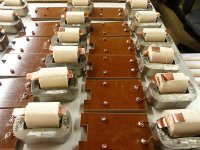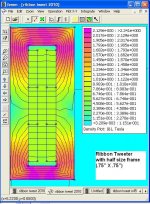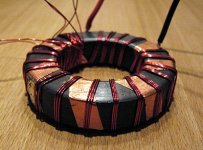o.k. it looks like he is still around it is Howard dawson Audio.
He has spare parts for Decca/Kelly ribbon tweeters and sells a pretty nice looking transformer for 30 pounds as well as ribbons and his own ribbon tweeter design .
I was considering buying a pair of his transformers to use with my ribbon tweeters
Howard Dawson Audio - spares for Decca/Kelly
He has spare parts for Decca/Kelly ribbon tweeters and sells a pretty nice looking transformer for 30 pounds as well as ribbons and his own ribbon tweeter design .
I was considering buying a pair of his transformers to use with my ribbon tweeters
Howard Dawson Audio - spares for Decca/Kelly
I was considering buying a pair of his transformers to use with my ribbon tweeters
Yeah, I have thought about them several times, but they look a bit "ordnary"
But could be they are custom made, and much better than they look
I think one deisgn goal with those trafos is that they should fit inside original Decca, and thus be small
One thing to remember is low end output
Those trafos are made for very small ribbons, and supposed to be crossed high
But C-core custom trafos will no doubt cost a lot more
Bruno
sandwich paper is bought in an ALDI store
Its very light, and somewhat soft in relation to pure foil
No rattle problems so far
It should be easy to remove paper, and get higher sensitivity
But as usual, the gain will most likely be more top end oriented
maybe even loose some lows as well
Free lunches are rare
hey, maybe it would be possible to design some kind of reversed OTL tubebuffer, but most likely not
Looks like I will go to Aldi tomorrow. Also, I have ordered 1.8 and 2.5 micron Alu foil. The plan is to compare the sensitivity of my tweeter with different thicknesses.Bruno
sandwich paper is bought in an ALDI store
Its very light, and somewhat soft in relation to pure foil
No rattle problems so far
It should be easy to remove paper, and get higher sensitivity
But as usual, the gain will most likely be more top end oriented
maybe even loose some lows as well
Free lunches are rare
What is your method of handling the foil? It's almost impossible to apply 1.8 um foil to the speaker with bare hands... I'm using 5 um capacitor foil and it's tearing almost without a reason...
What is your method of handling the foil? It's almost impossible to apply 1.8 um foil to the speaker with bare hands... I'm using 5 um capacitor foil and it's tearing almost without a reason...
I haven`t tried yet ... .
Have a look here:
Replacing the ribbon in a ribbon microphone
why so thin or soft ....
My goal is to reproduce the speed (transient) of life instruments. I want a very fast tweeter. Therefore I need a strong magnetic field (=big strong magnets) and a low moving mass (= thin foil). Presently I am using an ETON ER 4. It sounds nice but it is too slow.
Here is a commercial (expensive) tweeter that uses a 4 micron foil:
RAAL
Well i guess it depends on the frequency you will be confining your tweeter 2. I
have found 2 thin makes for a very weak sound , no percussive energy very , very apparent when making large ribbons ...
regards,
have found 2 thin makes for a very weak sound , no percussive energy very , very apparent when making large ribbons ...
regards,
Thats how it is with about everything we do; when we improve one end, we loose some at the other end
Its almost like a law of nature; what you put into it has to come from somewhere
its the reason for doing multiway speakers; its the same problems we are facing when trying to choose between a 2-, 3- or 4way
Its almost like a law of nature; what you put into it has to come from somewhere
its the reason for doing multiway speakers; its the same problems we are facing when trying to choose between a 2-, 3- or 4way
Do you know if increasing the magnets strength would also lead to weak sound?Well i guess it depends on the frequency you will be confining your tweeter 2. I
have found 2 thin makes for a very weak sound , no percussive energy very , very apparent when making large ribbons ...
Raal factory
Nice pictures from the Raal factory:
6moons.com - industry features: RoadTour Serbia, Exit Raal
Nice pictures from the Raal factory:
6moons.com - industry features: RoadTour Serbia, Exit Raal
I've been away from the DIY audio scene for a while and I was surprised to find this thread still going strong 5+ years after I started it. I'm thinking about building another ribbon that would be a variation of my original prototype from the very first post in this thread. The goal is to produce a high efficiency ribbon that can keep up with an efficient back loaded horn speaker.
It will have a single .5" X 6" aluminum ribbon, 2"X.5"X.5" n45 magnets and a metal frame made of .75" X 1.5" 1018 steel. The magnets are more than twice as powerful as those in the prototype and the steel frame is nearly three times the cross section of the original.
I found a great deal on the magnets; these are less expensive than the originals even though they are 2+ times as powerful:
Neodymium Magnets N45 2"x0.5"x0.5" Rare Earth NdFeB Magnets :: 1.0" < Length < = 2.0" :: Blocks :: Neodymium Magnets :: Neodymium Magnets || NdFeB Magnets || Rare Earth Magnets - Industrial Magnets & Assemblies, Super Powerful Magnets, Wind Solar Pow
The same seller also sells them on eBay for a little less (but the shipping is a little more):
12 PC N45 2" x 1/2" x 1/2" Neodymium Block Magnets - eBay (item 370425477861 end time Sep-04-10 01:00:44 PDT)
I'm going to use the same matching transformer as the prototype. Here is where the manufacturer sells the same ferrite toroid I originally used for $9:
https://www.amidoncorp.com/items/18
The best price I've found for the .75" X 1.5" 1018 steel is Online Metals:
Order Mild Steel 1018 Rectangle in Small Quantities at OnlineMetals.com
The total cost, including shipping is probably going to be ~$65 per driver. The biggest cost is the steel and its shipping. I know I could buy drivers for this amount but what would be the fun in that?
I've done a Femm simulation to optimize the field strength in the gap. I'm getting nearly 1 Tesla which is almost twice the original prototype. This should get me an efficiency in the ball park of what I'm looking for (90+ dBm).
As always, suggestions, comments or questions are welcome.
Denis
It will have a single .5" X 6" aluminum ribbon, 2"X.5"X.5" n45 magnets and a metal frame made of .75" X 1.5" 1018 steel. The magnets are more than twice as powerful as those in the prototype and the steel frame is nearly three times the cross section of the original.
I found a great deal on the magnets; these are less expensive than the originals even though they are 2+ times as powerful:
Neodymium Magnets N45 2"x0.5"x0.5" Rare Earth NdFeB Magnets :: 1.0" < Length < = 2.0" :: Blocks :: Neodymium Magnets :: Neodymium Magnets || NdFeB Magnets || Rare Earth Magnets - Industrial Magnets & Assemblies, Super Powerful Magnets, Wind Solar Pow
The same seller also sells them on eBay for a little less (but the shipping is a little more):
12 PC N45 2" x 1/2" x 1/2" Neodymium Block Magnets - eBay (item 370425477861 end time Sep-04-10 01:00:44 PDT)
I'm going to use the same matching transformer as the prototype. Here is where the manufacturer sells the same ferrite toroid I originally used for $9:
https://www.amidoncorp.com/items/18
The best price I've found for the .75" X 1.5" 1018 steel is Online Metals:
Order Mild Steel 1018 Rectangle in Small Quantities at OnlineMetals.com
The total cost, including shipping is probably going to be ~$65 per driver. The biggest cost is the steel and its shipping. I know I could buy drivers for this amount but what would be the fun in that?
I've done a Femm simulation to optimize the field strength in the gap. I'm getting nearly 1 Tesla which is almost twice the original prototype. This should get me an efficiency in the ball park of what I'm looking for (90+ dBm).
As always, suggestions, comments or questions are welcome.
Denis
Attachments
Hello Denis,
Do you see a relationship between the thickness of the steel plate and efficiency. A .75 inch thick steel plate is pretty stout .....
regards,
Do you see a relationship between the thickness of the steel plate and efficiency. A .75 inch thick steel plate is pretty stout .....
regards,
Denis,
Since you are building new transformers.... RAAL is now using a large Amorphous C-cores transformer on their ribbons. I attached a photo showing the husky transformer plus the use of copper foil instead of wire to wind the transformer. It looks like the C-cores allows RAAL to put the windings on a bobbin for easy assembly.
Since you are building new transformers.... RAAL is now using a large Amorphous C-cores transformer on their ribbons. I attached a photo showing the husky transformer plus the use of copper foil instead of wire to wind the transformer. It looks like the C-cores allows RAAL to put the windings on a bobbin for easy assembly.
Attachments
Dhenryp,
When i use femm,i look from the top , as a crossektion.

Wich one of the above looks like yours?
I do not think you will get twice the strength just from making the magnets twice the hight.And i do not think the steel has to be that large.
When i use femm,i look from the top , as a crossektion.

Wich one of the above looks like yours?
I do not think you will get twice the strength just from making the magnets twice the hight.And i do not think the steel has to be that large.
a.wayne - I need to have a steel frame with enough cross sectional area not to saturate with flux. My original prototype (from the first few posts of this thread) had .625" X .625 1018 steel and N40 .25" X .5" magnets. Looking back at the simulations now I think the steel was saturating and I could have gotten slightly better efficiency with thicker steel, maybe .75" X .75". You are right that .75" is stout (and heavy) material. .75" X 1.5" steel weighs nearly 4lbs per foot and each speaker will weigh about 10 lbs with it.😛
båndsei - I've attached a Femm simulation from the front with the frame about half size (~.75" X .75"). It gets about .75 Tesla in the gap while the full size frame (.75" X 1.5") gets about .95 Tesla. I would love to use smaller steel to save on steel and shipping but the simulation seems to call for the bigger steel if I want to get the last couple of tenths of Tesla. Efficiency-wise it probably only means a dB or two but I don't know if I will need them yet so I will probably spring for the extra $20 for steel.
My driver looks like your number 3 picture from the top. Take a look at the pictures from the first two posts on this thread to see the general shape; there are cross bars on the top and bottom but the space in back of the actual ribbon is open.
I've done simulations from the top but I don't think they work as well as from the front for my design. Simulating from the top implies that the frame is a total U shaped channel rather than the two crossbars in my design.
LineSource - The RAAL xformers are really interesting and I can see where they would be easier to manufacture. I think I'll probably stick with the toroids since I'll be winding them by hand (there are a relatively few number of turns) and I already have a source for them.
Denis
båndsei - I've attached a Femm simulation from the front with the frame about half size (~.75" X .75"). It gets about .75 Tesla in the gap while the full size frame (.75" X 1.5") gets about .95 Tesla. I would love to use smaller steel to save on steel and shipping but the simulation seems to call for the bigger steel if I want to get the last couple of tenths of Tesla. Efficiency-wise it probably only means a dB or two but I don't know if I will need them yet so I will probably spring for the extra $20 for steel.
My driver looks like your number 3 picture from the top. Take a look at the pictures from the first two posts on this thread to see the general shape; there are cross bars on the top and bottom but the space in back of the actual ribbon is open.
I've done simulations from the top but I don't think they work as well as from the front for my design. Simulating from the top implies that the frame is a total U shaped channel rather than the two crossbars in my design.
LineSource - The RAAL xformers are really interesting and I can see where they would be easier to manufacture. I think I'll probably stick with the toroids since I'll be winding them by hand (there are a relatively few number of turns) and I already have a source for them.
Denis
Attachments
Denis,
Since you are building new transformers.... RAAL is now using a large Amorphous C-cores transformer on their ribbons. I attached a photo showing the husky transformer plus the use of copper foil instead of wire to wind the transformer. It looks like the C-cores allows RAAL to put the windings on a bobbin for easy assembly.
Hello lines source ,
What have you found better to your liking .. Direct foil with transformer or multi traced foil without ?
a.wayne - I need to have a steel frame with enough cross sectional area not to saturate with flux. My original prototype (from the first few posts of this thread) had .625" X .625 1018 steel and N40 .25" X .5" magnets. Looking back at the simulations now I think the steel was saturating and I could have gotten slightly better efficiency with thicker steel, maybe .75" X .75". You are right that .75" is stout (and heavy) material. .75" X 1.5" steel weighs nearly 4lbs per foot and each speaker will weigh about 10 lbs with it.😛
Denis
Hello Denis , what if .25" x 2 " vs .75 x .75" ?
regards,
Last edited:
- Home
- Loudspeakers
- Planars & Exotics
- Another DIY Ribbon thread



